Running water is something we all take for granted. It’s been a basic feature of American homes for over 100 years. But up at Puckaway, we haven’t quite caught up, as there are a few major hurdles in the way. If you want potable (safe to drink) water around here, you need to drill down over 200 feet. We’re not putting in a proper well until we have a nice permanent home up here and know where we’re placing the slab.
Also, while we have always had a shallow well and outdoor pump to provide water that we can wash up with, it has a poor flow rate of under one gallon per minute. Additionally, we have to drain the pump and hoses when temperatures drop below freezing. And we don’t heat any of the buildings during the winter. Pipes would freeze and burst.
Last year, I reconnected all of the drain plumbing in the keep, but I wasn’t expecting much improvement on the supply side. We did what we had always done, storing 5-gallon buckets next to the sinks to wash up with and using our portable, hand-pumped, camping shower. Interestingly enough, this was all about to change because of a pressure washer.
I knew if I was going to paint or stain anything up here, I’d need to prep the surface first. And while a pressure washer seemed like the easiest solution, there was still the issue of supply. Even a small, electric model (like the one I planned on using) would require around two gallons per minute of water pressure flowing into it. Anything less, it would start pulling air and wouldn’t be able to function. There was no way our anemic little yard pump could provide this much pressure. It’s also pretty far away from the pole barn and some of the other things I wanted to clean. I had an ample supply of 55-gallon plastic drums which I could fill and use as reservoirs; I just needed to figure out how to pressurize them.
Yes, because I’m an idiot, my first errant thought was to put an air valve on the barrel and try to keep it at 60 psi using my air compressor. I dismissed this idea almost immediately because I didn’t know if that would even provide enough water pressure in the first place. It would require the air compressor to run almost continuously to keep up with the escaping water and it might accidentally just be a big, plastic-shrapnel bomb instead of a water pump. Next idea.
I researched some gas-powered pressure washers to see if any could also provide their own suction on the supply line. I didn’t find much out there. This is apparently not something most people need. Also, I didn’t like the thought of wrecking an expensive piece of power equipment by clogging the lines with the sediment-rich water from our shallow well. This was a dead-end, too.
I struck pay dirt after overhearing a co-worker talking about their RV. An RV! Something that can create the equivalent of municipal water pressure on-demand from an unpressurized reservoir. Exactly what I’m looking for. A little research and some Amazon-sleuthing later, and I found myself some test equipment. I could get a pump, an accumulator tank (keeps pressure in the lines when the pump isn’t running for smooth flow), and a strainer (gotta keep the lines clean!), all for around $120.
While I waited for this to arrive, I went to Menards and bought some lengths of PEX and various fittings and adapters. I wanted a PEX suction line that would run to the bottom of a 55-gallon drum, and another output line that that ended with a hose fitting to supply the pressure washer. I chose PEX because it’s flexible, easy to cut to exact lengths, and I already had all the tools necessary for attaching fittings.
I built a small mounting block for the pump and accumulator tank that would sit on top of the barrel. Once I had all my parts up at Puckaway, I secured the whole setup to one of the yard trailers. This way, I could fill the barrel at the yard pump, pull it with the ATV to wherever I needed to use it, and then I could run the pressure washer and pump off of an extension cord. And, hey, it worked! The pump had no problems keeping up with the demands of the pressure washer.
It worked so well, in fact, that I started thinking about other applications for it. I remembered seeing a large metal stand behind the woodshed that looked like it was meant to support a rain barrel. What if I set that up for the keep? Could I have running water from the taps?
After some testing in my garage at home, it sure looked like it. I ran some PEX through the walls and cabinets and installed the pump below the bathroom sink. I purchased some single-lever faucets online (because I wouldn’t need a hot water tap) and installed them in the kitchen and bathroom. Everything was supplied by a barrel mounted on a stand outside of the keep.
This was amazing. We could wash up indoors like actual, modern human beings. No more filling the sink and sloshing around in dirty water. I could even fill my camping shower from the tap. We enjoyed this new convenience all summer long. As fall came around, I couldn’t help but wonder if I could take things even further…
Of course I could. I had my eye on a tankless, propane-fueled water heater for a while, and finally ordered it once the price dropped below $100. I really wasn’t expecting it to work all that well, and I was very happy when it proved me wrong. This thing gets hot in a hurry, smoothly and efficiently turns itself on and off based on water flow, and is a lot less of a propane-hog than I was anticipating. It also comes with a shower head, as that’s it’s presumed single purpose. During some ill-advised, indoor testing (with the bathroom door and window open and a big fan blowing so as not to die from CO poisoning), I had the first, hot, high-pressure shower in Puckaway history. I knew we had a winner on our hands.
I replaced the single-tap faucets (one had already started leaking, so good riddance) with some cheap, plastic, hot-and-cold ones from Menards. I also set up a connector on the bathroom sink cabinet for the shower head and built a mount/enclosure for the pump components and heater so I could hang them outside by the barrel. This latest Puckaway improvement was unveiled at Puckaweekend 2016 where it was met with universal acclaim. As far as creature comfort upgrades go, this project is only rivalled by Outhouse 2.0.
- This project was born by happy accident. My pump and barrel reservoir setup for the pressure washer worked so well that I wanted to bring it indoors.
- The components of the pump system, from left to right: water inlet pipe, basket strainer, on-demand pump, pressure-equalizing accumulator.
- For the first several months, we just had a cold-water setup. The pump was mounted beneath the bathroom sink.
- The new outdoor pump enclosure. All electronics and connections are protected from the elements. Shown here with back panel removed.
- The reverse side, where the tankless heater mounts. This gets pretty hot during operation and needs to be out in the open air to operate.
- Mounted for initial testing in the garage. Note the fittings on the hot and cold output lines that allow for quick disconnection when the pack is put away for the winter.
- Hot water pump pack in place. Water is gravity fed from a 55-gallon barrel just out of frame.
- Quick and dirty PEX runs through the kitchen cabinet.
- Since this is a small setup that’s not left on while we’re gone, I didn’t bother with faucet valves and short service hoses. The PEX runs right into the faucets.
- A professional plumber would weep at this distribution system, but it works just fine for our purposes. The top-right line runs to the shower head.
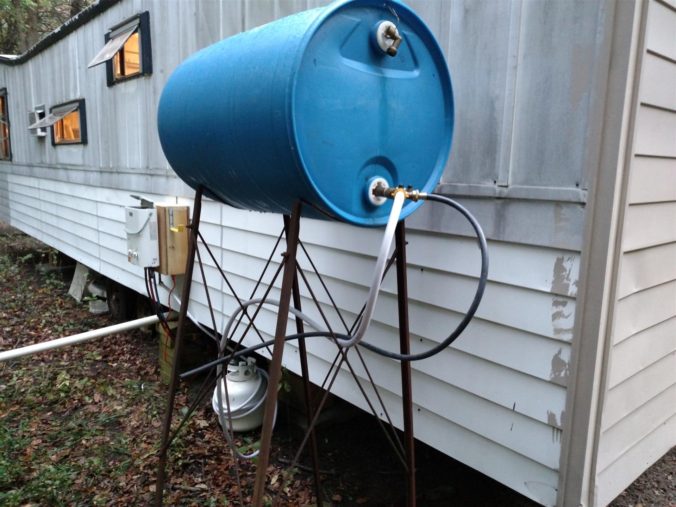
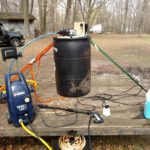
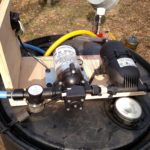
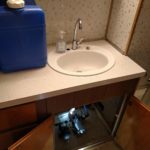
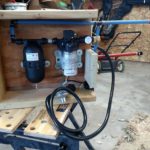
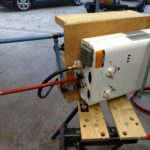
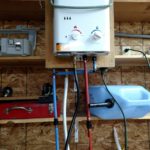
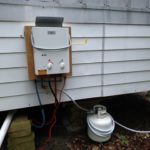

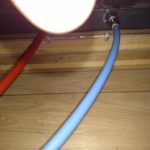
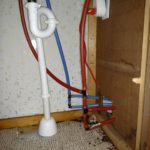

0 Comments
3 Pingbacks